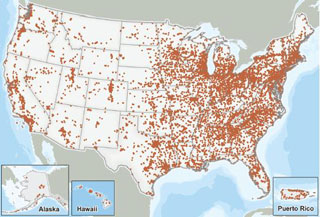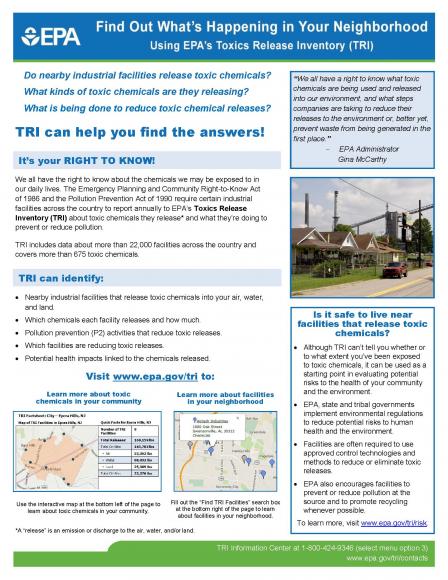Learn about the Toxics Release Inventory
On this page:
- What is the Toxics Release Inventory?
- What are the mission and vision of the TRI Program?
- What do the mission and vision of the TRI Program mean for communities?
- What are the goals of the TRI Program?
- Why was the TRI Program created?
- How is TRI different than other regulatory programs?
- Is TRI a mandatory program?
- What are TRI toxic chemicals?
- What types of industries are included in TRI?
- How does TRI relate to other EPA programs?
What is the Toxics Release Inventory?
TRI tracks the management of certain toxic chemicals that may pose a threat to human health and the environment. U.S. facilities in different industry sectors must report annually how much of each chemical is released to the environment and/or managed through recycling, energy recovery and treatment. (A "release" of a chemical means that it is emitted to the air or water, or placed in some type of land disposal.)
The information submitted by facilities is compiled in the Toxics Release Inventory. TRI helps support informed decision-making by companies, government agencies, non-governmental organizations and the public.
What are the mission and vision of the TRI Program?
The TRI Program's mission is to provide the public with information about TRI chemicals, including releases, other waste management (e.g., recycling), and pollution prevention from TRI-reporting facilities. To achieve this mission, the TRI Program:
- Develops regulations, guidance, and policies;
- Collects, manages and promotes the use of TRI data;
- Informs the public about possible exposure to TRI chemicals and related health and ecological risks, and highlights information facilities submit on reducing the use and release of these chemicals; and
- Assists government agencies, researchers, and others in research and data gathering.
The vision for the Toxics Release Inventory is that TRI is recognized as a premier resource for accessing information on possible exposure to toxic chemicals and pollution prevention activities that can reduce this exposure.
What do the mission and vision of the TRI Program mean for communities?
Since the creation of the TRI Program, the information collected and presented has provided a way for citizens to better understand possible sources of pollution in their communities. This better understanding can be the basis for actions, such as communications with facilities releasing chemicals to the environment and with regulatory authorities that have oversight responsibilities. This concept of citizen empowerment is summed up by the slogan, "A Right to Know, A Basis to Act.”
It is important to note that TRI information is most useful when presented in context. Information that is often helpful to citizens in addition to TRI quantity information includes the health effects of the chemical in question, how the chemical is managed, and whether a relevant human exposure is likely. Additionally, many parties including industry are often interested in whether releases of a chemical can be minimized, reduced, or eliminated at its source. The TRI Program is committed to presenting as much of this information as possible to help inform the public.
What are the goals of the TRI Program?
The three goals listed below express aspects of the TRI Program that are highly valued by TRI stakeholders and are considered necessary to effectively implement the TRI vision.
- Goal 1: TRI covers chemicals and sectors of concern to data users
TRI currently covers over 650 chemicals and chemical groupings and a wide range of industry sectors, many of which have been covered since the original Emergency Planning and Community Right-to-Know Act (EPCRA) established the TRI Program. EPA wants to ensure that the program covers all industry sectors and chemicals of concern and, accordingly, the TRI Program consistently examines and evaluates chemicals and sectors to enhance the TRI database for data users.
EPA is proactively considering the National Toxicology Program, international Pollutant Release and Transfer Register (PRTR) programs, and implementation of the Frank R. Lautenberg Chemical Safety for the 21st Century Act (2016) to identify possible modifications to the TRI chemical and sector listings. EPCRA also provided EPA the authority to add chemicals and industry sectors based on statutory criteria. Interested parties may petition EPA to request that chemicals or sectors be added or removed.
- Goal 2: TRI data are credible with quality suitable for TRI data uses
The quality of TRI information must be suitable to support the common uses of the information. EPA has taken steps to ensure data quality from the inception of the program and provides a number of resources to help facilities prepare their forms correctly and to correct errors when discovered. EPA also conducts a number of data quality checks on forms that are received.
The TRI Program is committed to an on-going program of activities to maintain and improve TRI data quality. To help facility representatives understand TRI reporting obligations, TRI provides a reporting hotline to answer questions. EPA is also developing improved guidance and on-line tools that may eventually reduce the reliance on the phone hotline.
The TRI Program currently conducts reviews of submitted forms to identify potential errors and data quality issues and is committed to helping facilities reduce the number of forms that require a correction. Further, as pollutant monitoring is becoming more common in many of the media programs, we expect that the best available data for TRI reporting will include more data based on measurements.
- Goal 3: TRI information is accessible, understandable, and is used to promote environmentally beneficial dialogue and decision making
TRI is meant to be a resource for the public, and increasing recognition and awareness of the program among potential users should lead to increased use of the information for a positive influence to improve public and environmental health. EPA continually seeks to make TRI data easier to access, understand and use through its reporting software and data tools.
TRI is often cited in articles and journals as an information source. Further, TRI information is obtained by access to the TRI tools, such as TRI Explorer, and the P2 Tool. As such, maintaining and improving access to TRI information through use of various tools and on-line applications is essential to the program.
Furthermore, the program’s intent is to facilitate the understanding of TRI chemical releases by placing chemical release amounts in context. This means providing the public with information about the health effects associated with the chemicals including toxicity weightings, risk-screening scores, and chemical management trends by facilities.
Why was the TRI Program created?
The TRI Program was created as part of a response to several events that raised public concern about local preparedness for chemical emergencies and the availability of information on hazardous substances.
On December 4, 1984, a cloud of extremely toxic methyl isocyanate gas escaped from a Union Carbide Chemical plant in Bhopal, India. Thousands of people died that night in what is widely considered to be the worst industrial disaster in history. Thousands more died later as a result of their exposure, and survivors continue to suffer with permanent disabilities. In 1985, a serious chemical release occurred at a similar plant in West Virginia.
In 1986, Congress passed the Emergency Planning and Community Right-to-Know Act (EPCRA) to support and promote emergency planning and to provide the public with information about releases of toxic chemicals in their community. Section 313 of EPCRA established the Toxics Release Inventory.
How is TRI different than other regulatory programs?
In 1986, TRI was part of a new approach to environmental protection. By making information about industrial management of toxic chemicals available to the public, TRI creates a strong incentive for companies to improve environmental performance. Information disclosure programs such as TRI are different than most federal environmental programs that are designed to achieve better environmental performance by setting standards and specifying how facilities must operate. TRI is also different because the information is updated annually and is reported to EPA directly from facilities.
Is TRI a mandatory program?
TRI is a mandatory program. The TRI Compliance and Enforcement webpage has more information.
What are TRI toxic chemicals?
In general, chemicals covered by the TRI Program are those that cause:
- Cancer or other chronic human health effects
- Significant adverse acute human health effects
- Significant adverse environmental effects
There are currently over 650 chemicals covered by the TRI Program. Facilities that manufacture, process or otherwise use these chemicals in amounts above established levels must submit annual TRI reports on each chemical. The TRI chemical list doesn't include all toxic chemicals used in the U.S.

What types of industries are included in TRI?
Facilities that report to TRI are typically larger facilities involved in manufacturing, metal mining, electric power generation, chemical manufacturing and hazardous waste treatment. Not all industry sectors are covered by the TRI Program, and not all facilities in covered sectors are required to report to TRI. See the Basics of TRI Reporting for more information.
How does TRI relate to other EPA programs?
A number of EPA programs collect chemical release and waste management information. Each of these programs has different requirements for who must report, what information must be reported and how often they must report. There is, however, some overlap between the facilities regulated by these programs and the facilities that report to TRI.
Users who want to find information that is not available in TRI can check the databases associated with these other programs. For example, the National Emissions Inventory (NEI) can be used to find estimates of air releases for facilities that do not report to TRI or for mobile sources such as cars, which are not covered by TRI. These databases include:
- RCRA Info – contains hazardous waste management information;
- PCS and ICIS-NPDES – contains monthly measurements of chemicals released to water at facilities with discharge permits;
- National Emissions Inventory (NEI) – contains air release estimates for stationary and mobile sources;
- Risk Management Plan (RMP) – contains risk management plans that state the amount of chemicals facilities have in on-site processes.
TRI overlap for air, water, and waste programs at EPA

For an explanation of this diagram and more information about the relationship between TRI and other EPA programs, please see pages 7-9 of Factors to Consider When Using TRI Data, available in English and Spanish.

